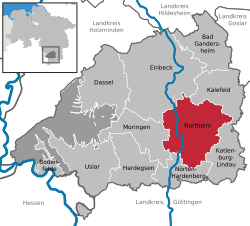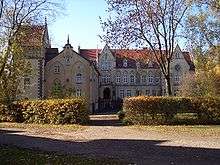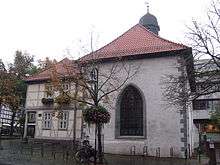Northeim
| Northeim | ||
|---|---|---|
| ||
 Northeim | ||
Location of Northeim within Northeim district  | ||
| Coordinates: 51°42′24″N 10°00′04″E / 51.70667°N 10.00111°ECoordinates: 51°42′24″N 10°00′04″E / 51.70667°N 10.00111°E | ||
| Country | Germany | |
| State | Lower Saxony | |
| District | Northeim | |
| Government | ||
| • Mayor | Hans-Erich Tannhäuser (Ind.) | |
| Area | ||
| • Total | 145.67 km2 (56.24 sq mi) | |
| Population (2015-12-31)[1] | ||
| • Total | 28,920 | |
| • Density | 200/km2 (510/sq mi) | |
| Time zone | CET/CEST (UTC+1/+2) | |
| Postal codes | 37154 | |
| Dialling codes | 05551 | |
| Vehicle registration | NOM, EIN, GAN | |
| Website | www.northeim.de | |
Northeim (Eastphalian: Nuurten) is a town in Lower Saxony, Germany, seat of the district of Northeim, with, in 2011, a population of 29,000. It lies on the German Half-Timbered House Road.
History
| Rittigau or County of Northeim | ||||||||||
| Rittigau or Grafschaft Northeim | ||||||||||
| Vassal of Holy Roman Empire | ||||||||||
| ||||||||||
| Capital | Northeim | |||||||||
| Government | Principality | |||||||||
| Historical era | Middle Ages | |||||||||
| • | First documentary mention of town |
800 | ||||||||
| • | First documentary mention of Rittigau |
982 | ||||||||
| • | First documentary mention of town as comital seat |
1002 | ||||||||
| • | Stem duchy of Bavaria in personal union |
1061–70 | ||||||||
| • | Comital line extinct | 1147 | ||||||||
| • | Northeim gained town rights |
1252 | ||||||||
| ||||||||||
| Today part of | | |||||||||

Northeim is first mentioned in 800 in a document recording a property transfer by a Frankish nobleman to the Abbey of Fulda. In the 10th century the surrounding region became a county, administered by the Counts of Northeim. The first of them, Siegfried is mentioned in 982. From 1061 to 1070 Count Otto II held the stem duchy of Bavaria as an Imperial fief, but lost it again because of his involvement in the Saxon plot against King Henry IV.
The monastery of St. Blasius was founded around 1100. In 1252 Northeim obtained town rights, and from 1384 to 1554 it was a member of the Hanseatic League. When protestantism was introduced in 1532 all the churches were allocated to the protestants. The town became part of the Kingdom of Hanover.
A part of Northeim was devastated by a fire in 1832 when the representative town hall dating from the Middle Ages and more than 40 houses burnt down. Further damage was caused by a fire in 1892 which destroyed several historic buildings in the Market Place.
After the railway from Hanover to Göttingen had been inaugurated in 1854 Northeim gained in importance and became a railway junction. The South Harz Railway was opened in 1868 and the Solling Railway in 1878. During the Second World War Northeim was hit by bombs in September 1944, February 1945 and in March 1945. The railway station, five factories and 18 houses were completely destroyed and 80 houses were damaged.[2] Fortunately the historic centre did not suffer severe bomb damage.
Northeim is the subject of William Sheridan Allen's book The Nazi Seizure of Power (ISBN 0-531-05633-3), a comprehensive study of the success of Nazism at town level. The book describes how the Nazis took over all social groups in the town and Nazified them, but failed to instill positive enthusiasm for the Nazi state. Instead, the population was "atomized" and deprived of the means to express group grievances. The book has been criticized for neglecting the role of the churches, which remained largely autonomous. However, even its critics say that the book is crucial to our understanding of Nazi Germany and has played a key role in shaping scholarship.[3] Imbshausen, the site of a post-World War II British sector Displaced Persons camp, was incorporated into the town in 1974.[4]
On 15 November 1992 an express train crashed into the wreckage of a derailed freight train near Northeim. Eleven people died and 52 were injured.[5]
Cultural amenities
- The town has a town museum and archive.
- There is an outdoor stage outside the town.
- The town is also home to a puppet theater, Theater der Nacht, which since 2001 has been housed in a redesigned fire station.
- Some of the old town wall still stands, including a watchtower.
Transportation
Hanoverian Southern Railway connects Northeim with cities like Göttingen and Hanover. Solling Railway connects Northeim with cities at the southern part of Solling-Vogler Nature Park.
Northeim also provides a small grass airfield (ICAO locator code: EDVN) due east of the town.
Notable natives and residents
- Otto of Nordheim, Duke of Bavaria
- Heinrich Kreipe, World War II general who died there (1976)
- Anna Naklab, singer-songwriter
Inhabitants
(each on December, 31)
|
|
|
Sights


There are many well-preserved half-timbered houses in the old centre of Northeim, e.g. in Wassergasse, one of the most pinturesque lanes, and in Kuhgasse, the narrowest lane of Northeim. The oldest half-timbered houses were built of oak wood in the 15th century. In many façades wood carvings are worth a look.
A part of the historic centre is still surrounded by the medieval wall which was built 1252 – 1305.
The oldest church of Northeim is Saint Fabian's and Sebastian's Chapel which was built in a typical gothic style in the middle of the 14th century and renovated in 1985/86.[6] Saint Sixti's Church was built from 1464 to 1517. It houses a gothic altar dating from 1420 and another altar created in the 16th century.[7] After the church had been allocated to the Protestants in 1539 there were no Catholics living in Northeim for several decades. The first catholic church to be built after the reformation was Saint Mary's Church outside of the historic town centre which was founded at the end of the 19th century.
Saint Spiritus Hospital is a large half-timbered house with wood carvings built around 1500.
Saint Blasii is a former monastery which was founded in the 11th century and dissolved in 1592 after the reformation.
In the village of Imbshausen which was incorporated into the city in 1974 a castle built 1862–64 in a large park is worth a visit.
See also
References
- ↑ Landesbetrieb für Statistik und Kommunikationstechnologie Niedersachsen, 102 Bevölkerung - Basis Zensus 2011, Stand 31. Dezember 2015 (Tabelle K1020014)
- ↑ Niedersächsisches Städtebuch. Braunschweig 1952
- ↑ The Nazi Seizure of Power: The Experience of a Single German Town 1922–1945, Times Higher Education
- ↑ Imbshausen on Heraldry of the World
- ↑ accessed 2013.01.18
- ↑ G. Ulrich Großmann: Hannover und Südniedersachsen, p. 227. Cologne 1999
- ↑ G. Ulrich Großmann: Hannover und Südniedersachsen, p. 228. Cologne 1999
External links
| Wikimedia Commons has media related to Northeim. |
- Official website
-
 "Northeim". Encyclopædia Britannica (11th ed.). 1911.
"Northeim". Encyclopædia Britannica (11th ed.). 1911.
